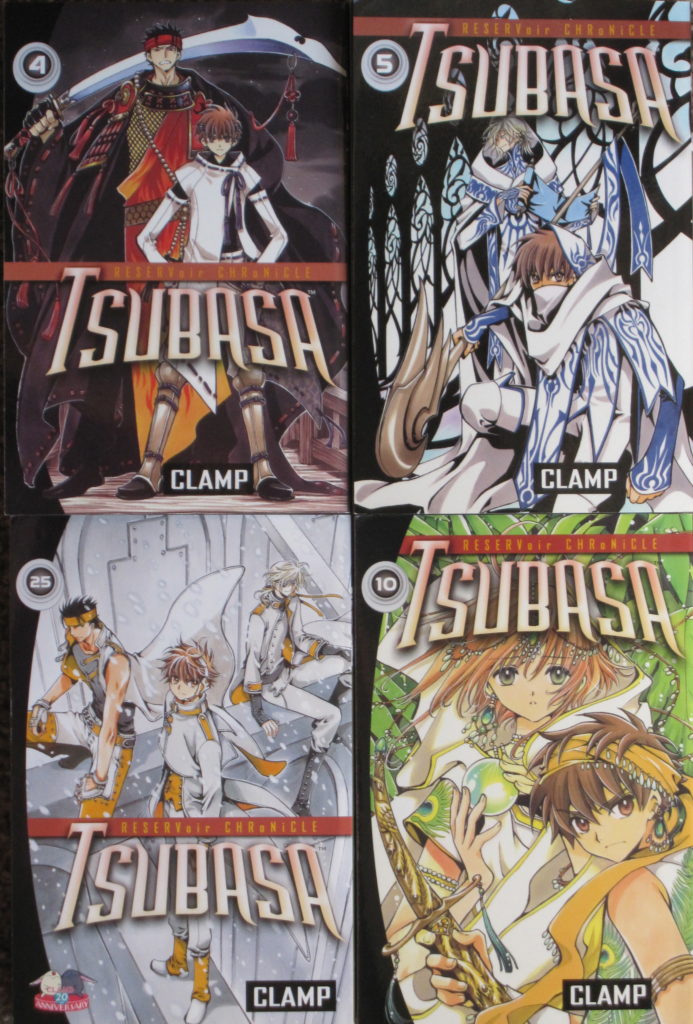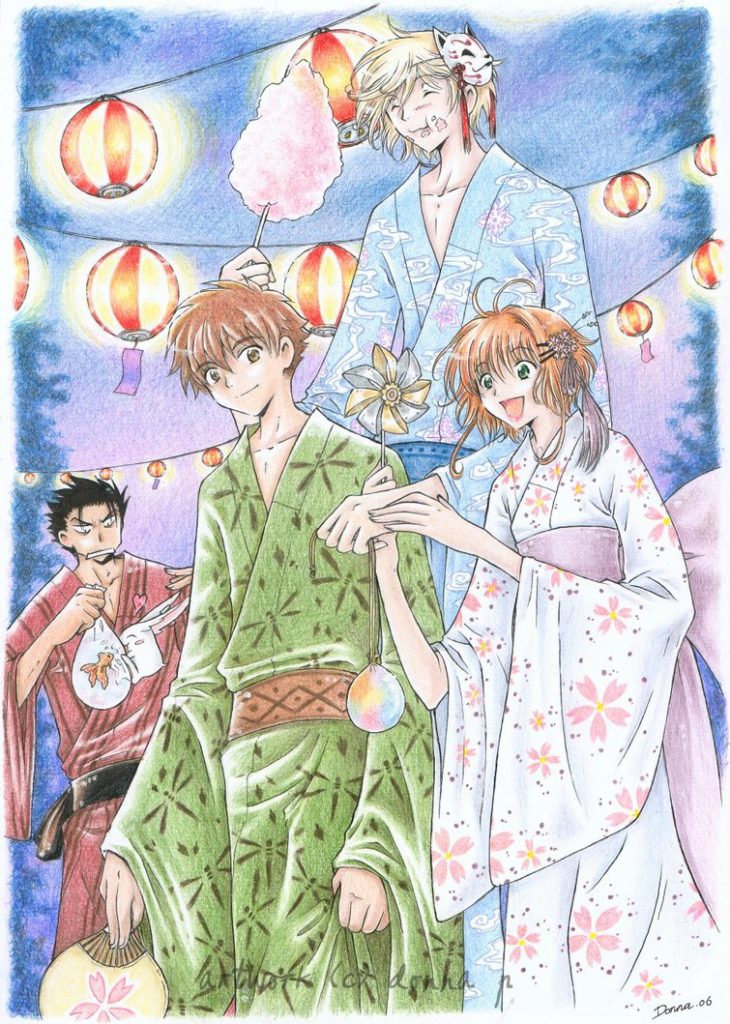This week’s Friday Media Review focuses on Tsubasa: RESERVoir CHRoNiCLE (Tsubasa for short), a manga series by the famous manga-ka group CLAMP.
Tsubasa is a fantasy manga that begins in an alternate world that is similar yet different from Earth. The idea of “alternate worlds” is very important to Tsubasa, since from the first volume the main characters find that they must travel across dimensions (from world to world) to find what they desire. There are four main characters: Sakura, a princess whose memories were lost and scattered across many worlds; Syaoran, a young, orphaned archaeologist who is helping the princess to seek her memories; Kurogane, a fierce, dark ninja who wants to return to his home world; and Fai, a mysterious magician whose smiling face conceals his true feelings. Together they are given a way to travel across dimensions and seek out the princess’ feathers: the creature Mokona, a living dimension gate and requisite cute comedy relief for the story.
Tsubasa is interwoven with another manga series by CLAMP, xxxHolic. xxxHolic (pronounced “holic”) has nothing to do with the concept of “xxx”, so don’t get turned off – or turned on, if that’s your thing – by the title. Instead, xxxHolic is a story that takes place on modern-day Earth, and follows the supernatural shenanigans of Watanuki, a high school student in Japan. As developments play out between the two stories, one can see how the two series are intimately connected while still being separate enough to read independently – it just may increase your enjoyment of both to read them in parallel.
Now about Tsubasa – there’s an awful lot to like about this particular series, enough so that it was hard to choose what to talk about! But a few things stood out to me as highlights. First, and as always, CLAMP’s art is frankly impressive. There’s a richness of detail yet clarity of line that make it very clear what is going on while still giving the texture and feel of the surroundings. The characters themselves are drawn with an incredible variety of expression while still being true to themselves, and the movement in the fight scenes (and oh yes, there are several great fight scenes!) is exciting and intense.
The relationships between the characters is the true glue for this series. As the four main characters get to know each other better, you start to gain an understanding of the deeper motivations they have and the difficulties each of them has passed through, and you respect them more and more. But beware of becoming complacent – just as you think you know what’s going on and can predict what will happen in the story, CLAMP pulls the rug out from under you. There are a few neck-kinking plot twists that make complete sense during the course of the story but that will still leave you making a flow chart to keep track of the characters and their relationships.
Another aspect of the story that I personally enjoyed was the unfolding romance between Sakura and Syaoran. CLAMP used the characters (in a younger form and different “world”) in their series Cardcaptor Sakura, and there’s deep enjoyment in seeing the fulfillment of a much-desired romantic relationship between them – a relationship that would have made me uncomfortable if they were both fourth graders. These characters are similar but fully themselves, and establish themselves without needing to borrow from past glories.
Another thing that I enjoyed a lot was seeing the spectacular variety of worlds that the characters travel to. There’s something from almost every genre – an underwater world of Lilliputian proportions, a charming Victorian-era world, a world wrapped in endless battle, a cheerful technologically-advanced world, a bleak post-apocalyptic world, and a world within a video game, to name just a few! You never get tired of the scenery, because if you wait just a few chapters, it’s sure to change. CLAMP also sprinkles characters from their various previous series into the mix, making cameos left and right – it’s not necessary to recognize all of them to enjoy the story, but fans of CLAMP’s work will get an extra thrill from all the familiar faces.
There were a few things that I thought could have been done better in this series. As I mentioned, CLAMP has populated a lot of the worlds with characters from their past series. Usually they’re well written and worked into the story, but occasionally you see a full page spread of a character or a locale and go, “Why the heck did they focus on that?” For me, I was bemused by a few scenes in volume 14. On pages 162-163, Fai says, “It looks like we can take shelter in that building!” and there is a corresponding two-page spread of a double tower. The translator William Flanagan made a point of mentioning why CLAMP focused on “That Building” in his end-of-volume notes, probably because he was also somewhat struck by the incongruity of the image. There were also a few characters that looked like they had very detailed designs that ended up having no significance in the story whatsoever – breaking with the tradition of manga that if a person has crazy hair and/or eyes, they will be important to the plot.
The last gripe I have with the series is that while the first few plot twists are easy to follow, the end-of-story plot twist and final interaction between the characters becomes almost incomprehensible. This is not helped by the fact that several of the characters in the last volume are practically identical in appearance. There are interactions not only across space and across dimensions, but across time as well, and whenever there’s a time loop, there’s gonna be a headache. If I could ask them to change something, I would ask that they would include more identifying marks on the characters so that there was a way to tell them apart – and a flowchart of relationships in the last book wouldn’t be a bad idea either.
One person who impressed me with his thorough work and genuine affection for this project is William Flanagan, credited on the title pages with “Translated and Adapted by William Flanagan”. Mr. Flanagan did a fantastic job throughout the series of translating CLAMP’s complicated and at times intentionally vague dialogue, and coming up with the best possible English expression or substitution for the Japanese idea. I also really appreciated that he included a section called “Translation Notes” at the end of every volume that explained and discussed the more obscure points of translation, Japanese culture and CLAMP’s past works. His witty and useful notes added much to my enjoyment of the series. I also appreciated the editorial decision not to replace Japanese sound effect art with English equivalents. Instead, the translation of the onomatopoeia is written in small letters next to the Japanese sound effect. While it might not matter for many artists, for CLAMP the arrangement of the sound effects are as much part of the overall composition of a piece as the character or event happening on the same page. That’s a personal preference, but in this case I believe entirely justified – and in fact, there’s one character in the series who uses sound effects as attacks, so it was probably practical from an art standpoint as well.
I guess what I’m trying to say through this entire review can be summed up in just a few words. All in all, Tsubasa: RESERVoir CHRoNiCLE is a complex and satisfying series that will keep you interested and somewhat in the dark until the very last page. It is a recommended read for anyone who enjoys fantasy, beautiful art, and well-written dialogue within a well-thought-out story.


